
11 Must-See Destinations in North Iceland


What are some of the more unique "must-see destinations" in North Iceland? What makes them so special, and is it possible to visit them in all seasons? Read on to discover the 11 Must-See Places in North Iceland for your travel itinerary!
From the earliest Norse settlements to some of the most picturesque and unique attractions in the country, the North has much to offer travelers visiting Iceland this year. Its untouched nature, historic landmarks, and vibrant culture all make it well worth the visit... once or multiple times!
If you want to explore this great region, it's good to find a base for your travels, so make sure to book a hotel in North Iceland before you head on your journey. To be able to go from place to place easily, you should book a rental car for your travels or simply take tours from Akureyri.
Without further ado, here is our list of 11 places in the North of Iceland that you definitely must see during a visit!
- Read more: The 13 Best Things to Do in Akureyri
- See also: 15 Hidden Destinations in North Iceland
Towns to Visit in North Iceland
You'll find many charming towns and villages along the coast of North Iceland, including the largest town in the region, Akureyri! Here are some gems worth adding to your travel itinerary.
Siglufjordur
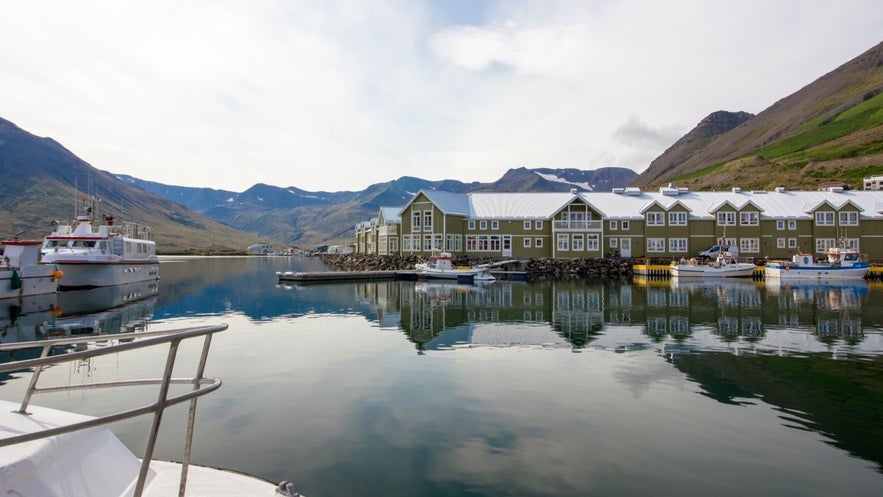
Situated in a narrow fjord, Siglufjordur is a small and picturesque Icelandic fishing town. Despite its relatively small size, it was once the main location for herring fishing in the North Atlantic. The population of the area expanded to 3,000 during the herring boom of the 1940s and 1950s, becoming the 5th largest town in Iceland, but has since declined due to the industry's decline.
Today, Siglufjordur’s population sits at around 1,300. It is about a one-hour drive from Iceland’s unofficial northern capital, Akureyri.
This charming town features some interesting cultural attractions. It's where you'll find the Herring Era Museum, which chronicles the importance of the ocean to the survival of Icelanders throughout its history. In fact, it is one of the largest ocean industry museums in the country. Split into three separate buildings, the museum chronicles the fishing process, showcases ships from the 1950s, and even provides insight into the herring salting process.
On some days, travelers are even able to view the salting process in action! Include a visit if you're in the area, as it's one of the best museums in Iceland.
Music is also an important part of the history of Siglufjordur. The Folk Music Centre celebrates the life of reverend Bjarni Þorsteinsson, better known to locals as "The Father of Siglurfjordur." The center celebrates a rich history of traditional folk music in Iceland, which is brought to life through actual recordings, transporting visitors back in time.
In early July each year, Siglufjordur also hosts its own folk music festival. It’s an international affair that draws performers and folk music lovers from all over the world. The festival boasts conferences, performances, and workshops, dramatically increasing the traffic to the area throughout its duration.
The town is framed by a beautiful fjord and high mountains, making it a popular destination for seasoned hikers, as well as boasting incredible opportunities for bird watching. There are nice restaurants, a café, and a bar, along with a small geothermal swimming pool. Book a stay in Siglufjordur and enjoy your time in this charming town!
Husavik
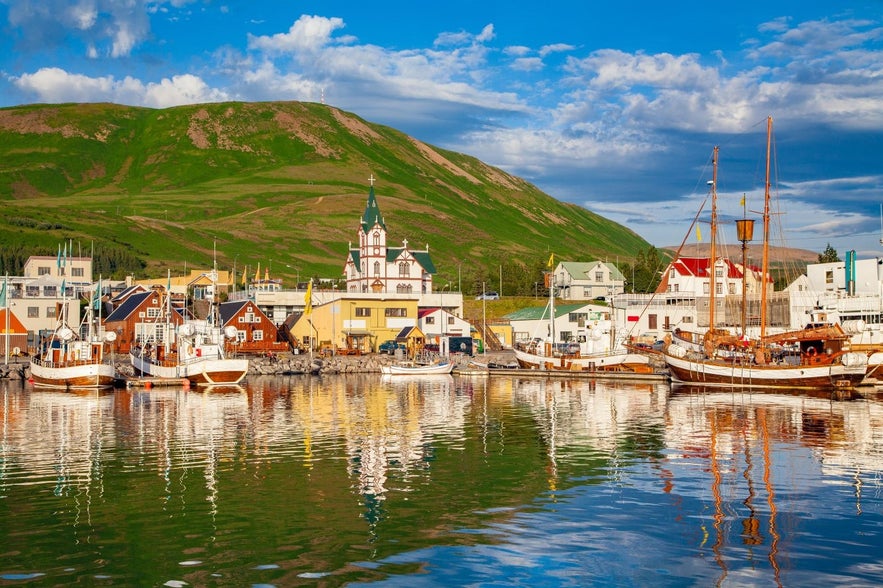
According to the Book of Settlement or "Landnámabók," Husavik was the first area in Iceland to be settled by a Norseman. A Swedish Viking, Garðar Svarvarsson, spent a winter there in 870 A.D.
When he moved on the following spring, he left behind a man and two slaves (a man and a woman). They established a farm, which became Husavik. The town’s name means "Bay of Houses," and it is believed this name refers to the homes Garðar built there.
Today, Husavik has affectionately earned the nickname of "the whale-watching capital of Iceland." This is because, during the summer months, many tour operators can boast a 100% sighting rate, making it one of the best places in Iceland for whale-watching tours.
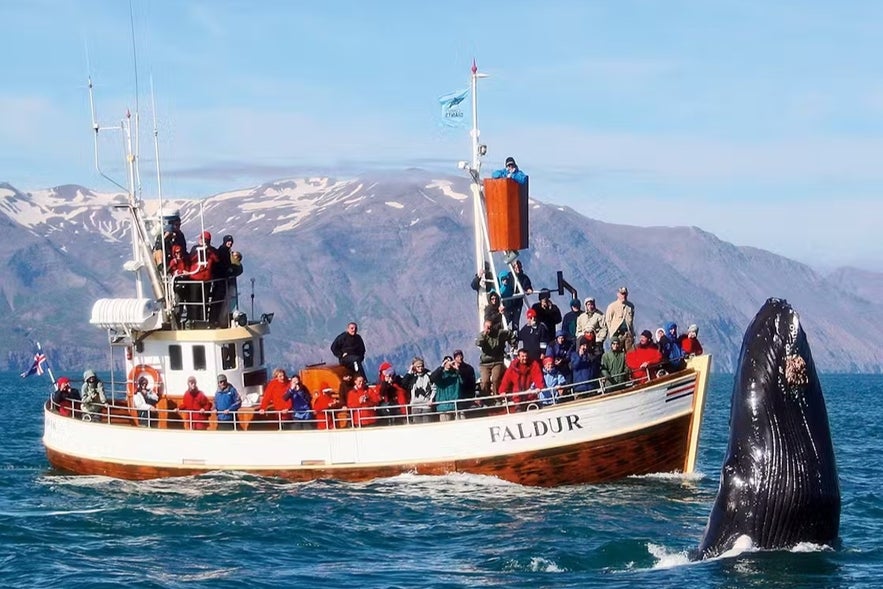
Photo from The Húsavík Whale Watching Tour
The most common whale to see during a Husavik whale-watching tour is the humpback whale. Humpbacks are incredibly popular with whale watchers because of their acrobatic behavior, gargantuan size, and natural curiosity.
These gentle giants of the sea are known for breaching, fin-slapping, and raising their enormous tails out of the water when they dive. Other marine life seen in the bay includes white-beaked dolphins and harbor porpoises, but on some occasions, fin whales and even orcas have been spotted in the area.
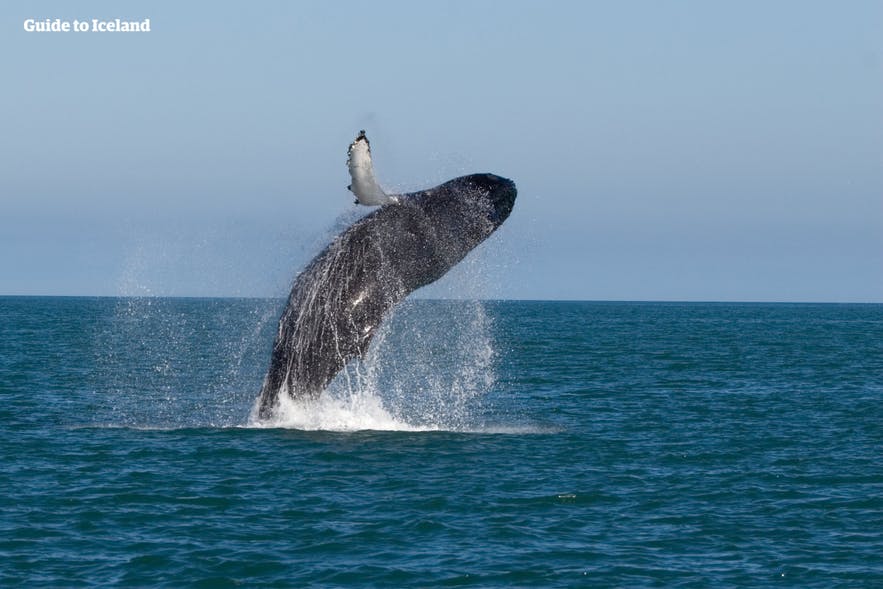
If whale watching isn’t enough, Husavik also has a whale museum. It was established in 1997 as a small exhibition in a hotel, but by 2005, it had been moved to its own location by the harbor. The museum focuses on the entire ecology of whales.
Husavik has also gained international attention in recent years as it featured in the Netflix film Eurovision Song Contest: The Story of Fire Saga, starring Will Ferrell and Rachel McAdams. The key song of the film celebrates the town of Husavik, and it even received an Oscar nomination!
During a visit to the town, you can stop by the Jaja Ding Dong bar, which references another song from the film, along with the fun Eurovision exhibition!
 Once you've explored all that Husavik has to offer, you can head to the edge of town for a unique hot spring experience. The Geosea Sea Baths are filled with geothermally heated saltwater and offer a great chance to relax.
Once you've explored all that Husavik has to offer, you can head to the edge of town for a unique hot spring experience. The Geosea Sea Baths are filled with geothermally heated saltwater and offer a great chance to relax.
The warm water is soothing, and there's an in-water bar if you want to treat yourself. The baths offer incredible views over Skjalfandi bay, which is especially beautiful in the sunset. Remember to book your Geosea entry ahead of time to ensure availability.
To enjoy all that this town has to offer, we recommend staying a night in accommodation in Husavik for the best experience.
Hofsos
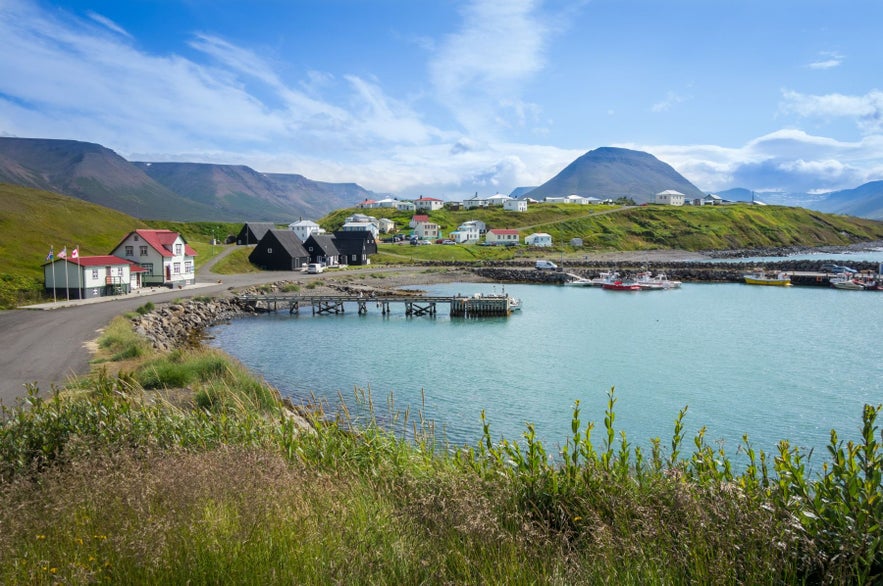 Hofsos is one of the oldest trading ports in Iceland, dating all the way back to the 16th century. It had all the hallmarks necessary to develop into a much larger town, but for reasons that are something of a mystery, it didn’t. Today, the village has a population of around 160 people.
Hofsos is one of the oldest trading ports in Iceland, dating all the way back to the 16th century. It had all the hallmarks necessary to develop into a much larger town, but for reasons that are something of a mystery, it didn’t. Today, the village has a population of around 160 people.
Hofsos is situated about 23 miles (37 kilometers) east of Saudarkrokur and is home to the Icelandic Emigration Centre. The center is dedicated to the westward migration of Icelanders to North America at the start of the 19th century, and they have an interesting history exhibition.
While people from all over Iceland migrated, it's particularly fitting for the center to be located in Hofsos. It was from this area where Thorfinnur Karlsefni sailed to find a new life in what is now known as Newfoundland in Canada. He and his wife, Guðríður Thorbjarnadóttir, had a son, Snorri Thorfinnsson, who is believed to be the first European born to immigrant parents in North America.
The museum honors the 16,000 to 20,000 Icelanders who sought a new life in America between 1850 and 1914. The town also boasts enjoyable shore walks where travelers can view hexagonal basalt columns.
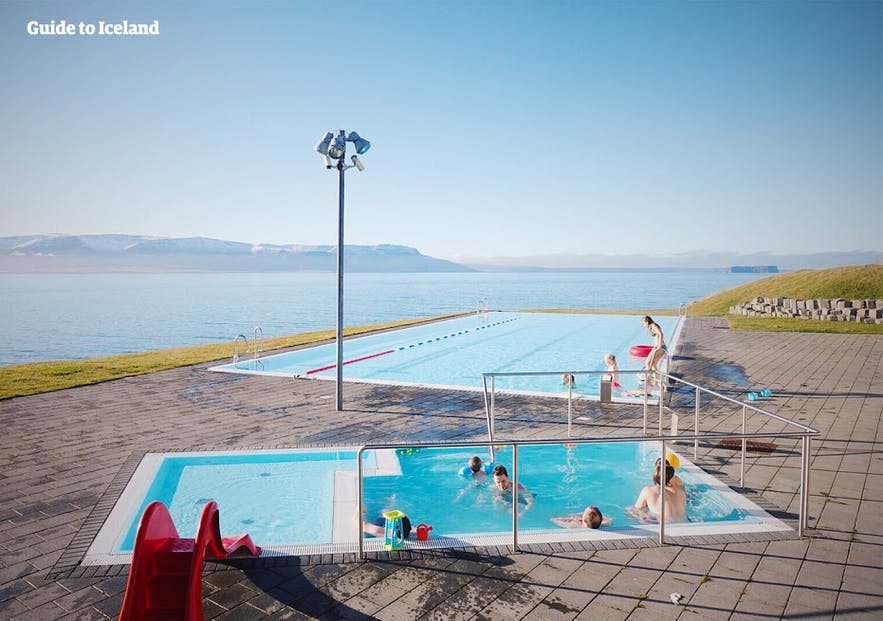
The town is also known for the fantastic Hofsos swimming pool. It's considered one of the best geothermal public pools in Iceland because of the beautiful views it offers over the Skagafjordur fjord!
If you plan to stay in accommodation in Hofsos, you can explore the historic area surrounding the town. The Skagafjordur fjord is the location of many significant events from the Icelandic Sagas, including the biggest battle in Iceland's history, Orlygsstadabardagi. You can visit the 1238 Battle of Iceland exhibition to learn more about it and even step back in time with a VR simulation!
- For more, check out the History of Iceland
Dalvik
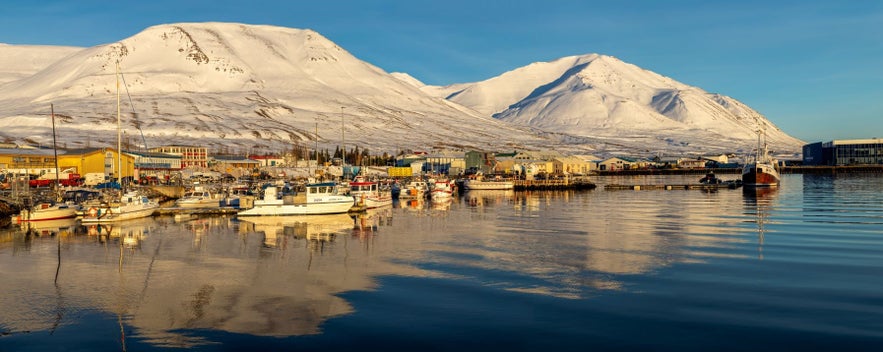 Dalvik is a tranquil town nestled at the roots of the towering Trollaskagi peninsula mountains, just a 35-minute drive from Akureyri. Fishing is the backbone of the local community, which is reflected in the lively Dalvik harbor. From there, you can experience the sea for yourself during this family-friendly whale-watching tour!
Dalvik is a tranquil town nestled at the roots of the towering Trollaskagi peninsula mountains, just a 35-minute drive from Akureyri. Fishing is the backbone of the local community, which is reflected in the lively Dalvik harbor. From there, you can experience the sea for yourself during this family-friendly whale-watching tour!
Afterward, you can stop for a bite at a charming café or relax in the Dalvik swimming pool. The town is also known as the best place in Iceland for alpine skiing, so keep that in mind if you're planning to visit Iceland in winter! Unsurprisingly, many Icelandic Olympic skiers have come from here.
Dalvik was also home to the tallest Icelander on record. Jóhann Kristinn Pétursson lived there from 1913 till his passing in 1984. He was 7.67 feet tall (2.34 meters) and was nicknamed Jóhann risi or "the Giant" by locals. A museum was established in his honor, but unfortunately, it's temporarily closed due to maintenance.
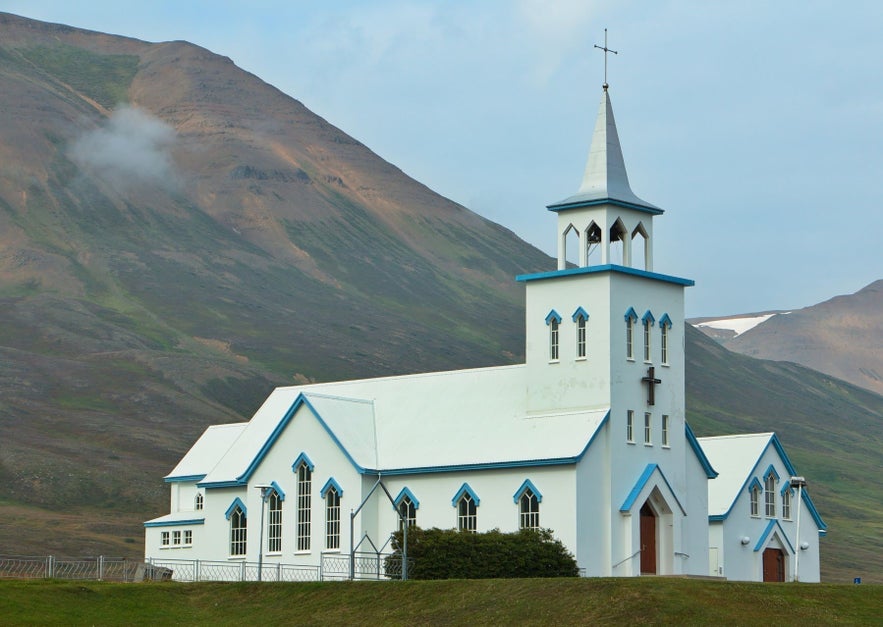
If you're in the area, take the time to stroll through this lovely town and enjoy the views of the Breidafjordur fjord. The Dalvik church is also very beautiful and worth checking out!
You can find some comfortable accommodations in Dalvik, and it can make for a convinient base for exploring the surrounding region. Also, if you're interested in visiting Grimsey island, this is the best place to stay, as it's the departure point of the Grimsey ferry!
Natural Attractions in North Iceland
The northern region of Iceland is home to some true natural marvels. These are the top locations you must include on your itinerary during a North Iceland road trip!
Grimsey Island
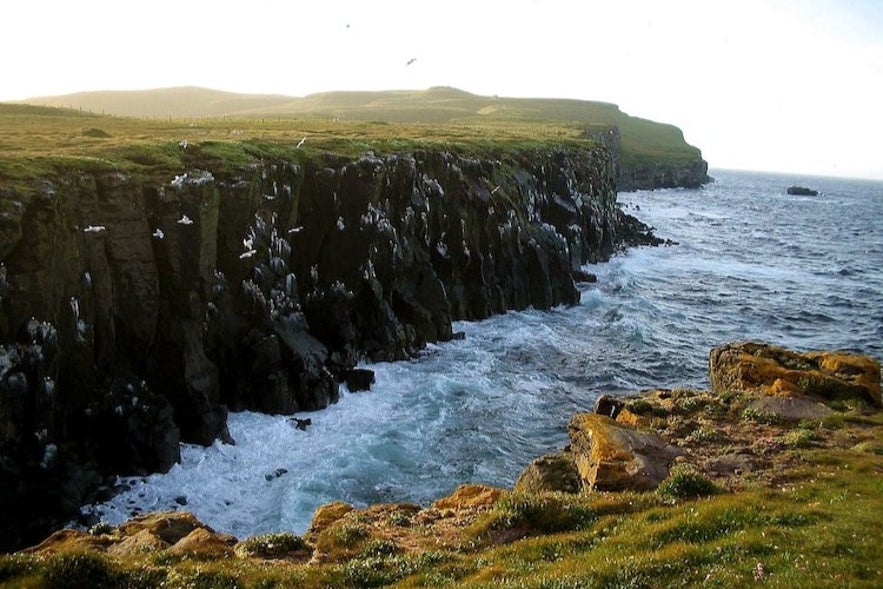 Photo from Wikimedia, Creative Commons, by MosheA.
Photo from Wikimedia, Creative Commons, by MosheA.
Grimsey island is the northernmost inhabited landmass in Iceland. It’s situated about 24 miles (40 kilometers) off the coast of mainland Iceland and straddles the Arctic Circle so closely that it is, in fact, the only part of Iceland that is genuinely in the Arctic. You can visit by ferry from Dalvik or this Grimsey airplane trip from Akureyri.
Because of natural oscillations of the Earth’s axis, the boundaries of the Arctic Circle shift by about 9 miles (14.5 meters) per year. This means that by the mid-21st century, Grimsey will no longer be part of the Arctic Circle!
A monument to Grimsey’s crossing with the Arctic Circle was erected years ago, but in 2017, a second monument was constructed to reflect its movement. It's called Orbis et Globus or "Circle and Sphere," and it's an 8.8-ton stone sphere that's moved every year to reflect the movement of the Arctic Circle.
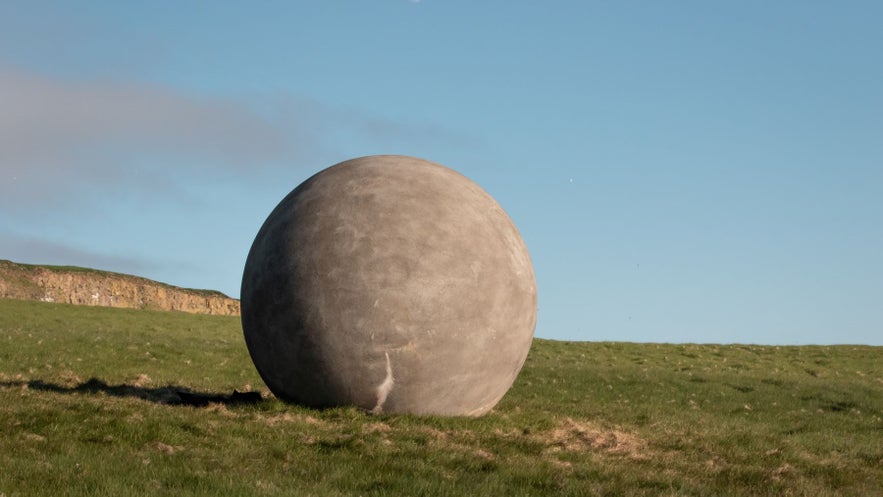 Since its construction, the Orbis et Globus memorial has become one of the most visited spots on the island. Walking to the sphere and back again takes around three hours, so it's best to stay a night in Grimsey. The stopping time of the Grimsey ferry and the airplane is too short to enjoy the must-see things on the island!
Since its construction, the Orbis et Globus memorial has become one of the most visited spots on the island. Walking to the sphere and back again takes around three hours, so it's best to stay a night in Grimsey. The stopping time of the Grimsey ferry and the airplane is too short to enjoy the must-see things on the island!
During a visit, you'll have to explore the island's tiny town. We recommend taking the little "train" that drives around the main attractions of the island, though it doesn't include the new Orbis et Globus monument.
The town also used to feature a beautiful wooden church, but it burned down in 2021. It was originally built in 1867 and housed a 100-year-old locally produced imitation of a Leonardo Da Vinci painting! Many locals are now volunteering to help build a new church in Grimsey, which is close to being finished.
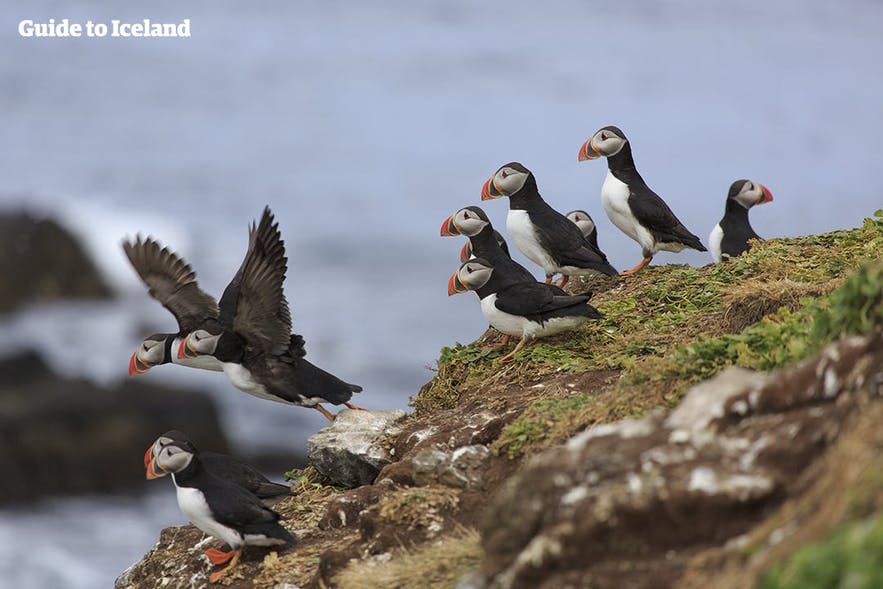
Once the town has been explored, take the time to see the nature of the island. Although the island is almost entirely treeless, Grimsey is home to a vast array of natural vegetation, mainly marshland, grass, and moss. On top of that, the high elevation of the island's cliffs, as well as its lack of predators, make Grimsey a haven for native bird life, especially puffins!
The majority of visitors flock to the island to see the Atlantic puffins, which nest there until their winter migration. However, Grimsey is home to an extensive list of birds, including Auks, Razorbills, and the Northern Fulmar.
- See Also: Birds in Iceland
Asbyrgi Canyon
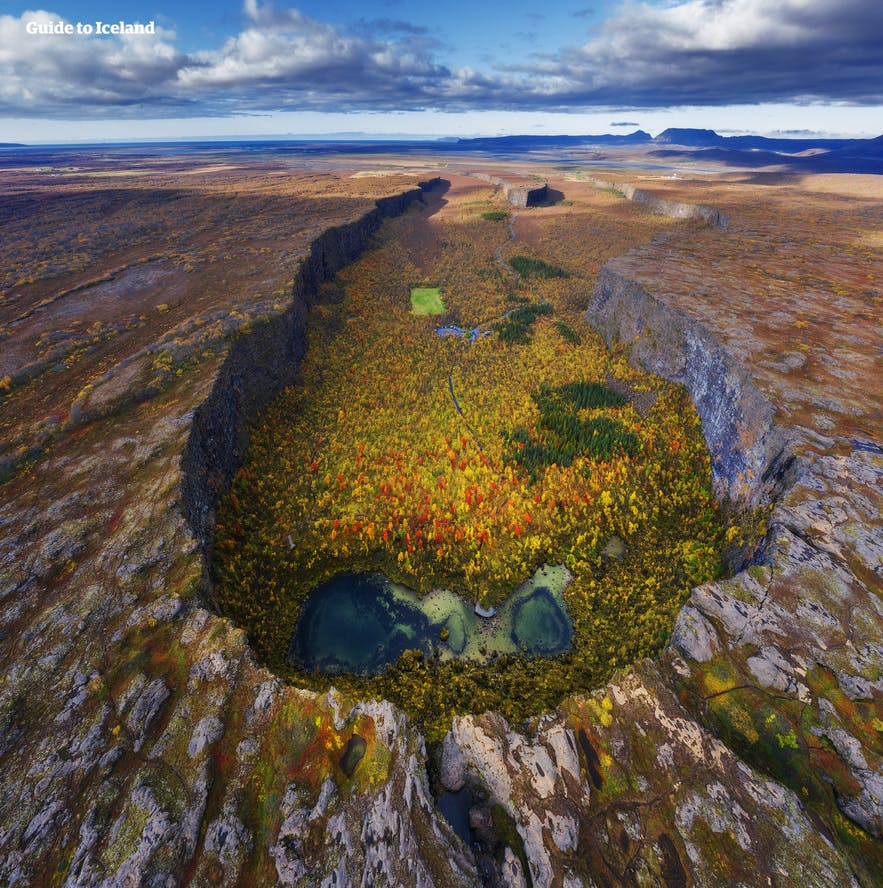
Asbyrgi canyon is a popular tourist destination situated about 23 miles (38 kilometers) east of Husavik. The canyon is shaped like a horseshoe and is part of Vatnajokull National Park, and it's a stop on the Diamond Circle route.
The Asbyrgi canyon was most likely formed by glacial flooding after the last ice age between 8,000 and 10,000 years ago! Its steep 328-foot (100-meter) cliffs with birch and willow-littered woodland provide some of the most breathtaking views in the country.
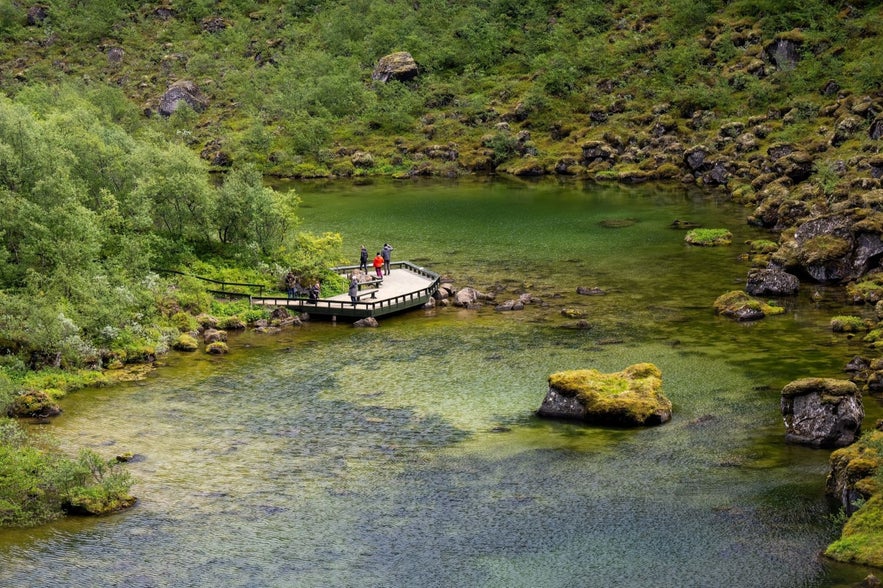 Icelandic folklore states that its horseshoe shape was created by the god Odin’s eight-legged horse "Sleipnir" stepping on the ground. Other local stories detail that Asbyrgi is the capital city of Iceland’s "Huldufólk," or hidden people.
Icelandic folklore states that its horseshoe shape was created by the god Odin’s eight-legged horse "Sleipnir" stepping on the ground. Other local stories detail that Asbyrgi is the capital city of Iceland’s "Huldufólk," or hidden people.
Many Huldufólk believers claim to have seen these magical creatures in some of the caverns and cracks of the canyon. You might not be lucky enough to see one, but you may stumble across another elusive creature: the Arctic fox!
- See also: Folklore in Iceland
- Learn more about the Arctic Fox | A Tale of Iceland's Only Native Mammal
Not far from Asbyrgi canyon is Jokulsagljufur canyon, which used to be its own national park until it became part of the Vatnajokull National Park in 2008. Jokulsagljufur is interesting to travelers and geologists alike because of its chaotic canyon and volcanic cliffs. Eight thousand years ago, a volcano erupted there, and the result over time created strange rock columns which have been named Hjodaklettar or "rock of echos."
Dettifoss Waterfall
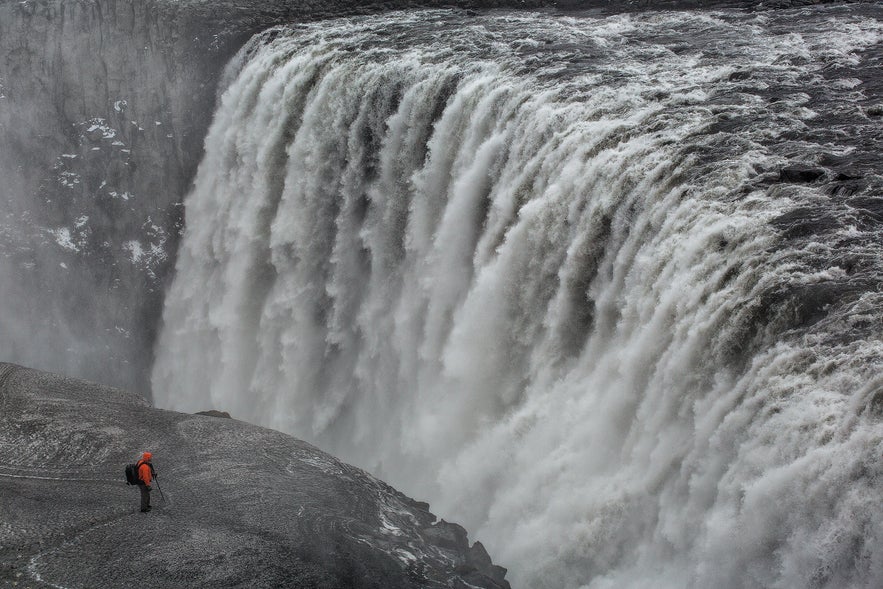
Dettifoss is one of the most powerful in Europe and a main stop on Diamond Circle tours. Science fiction fans might recognize Dettifoss from the opening scene of Ridley Scott’s 2012 science fiction film Prometheus!
It flows from the Vatnajokull glacier, and as the water runs, it collects sediment, turning the water a greyish-white. The result is an awe-inspiring, otherworldly natural wonder. The falls are 328 feet wide (100 meters) and have a drop of 144 feet (44 meters) into the Jokulsargljufur canyon.
- See more: Waterfalls in Iceland
- Also, check out Movie Locations in Iceland: The Complete List
Dettifoss’ waters run at an average rate of 431.7 miles per hour (193 meters per second). To the west bank of the falls is a well-maintained hiking path and viewing platform, which allows visitors to get a safe view of the power of this natural beauty accompanied by its almost deafening roar. You can also visit the eastern side for an alternative view.
We recommend taking a short detour to the nearby Selfoss waterfall during your visit. It's just a 10-minute walk upstream from Dettifoss, and it's very beautiful.
Lake Myvatn
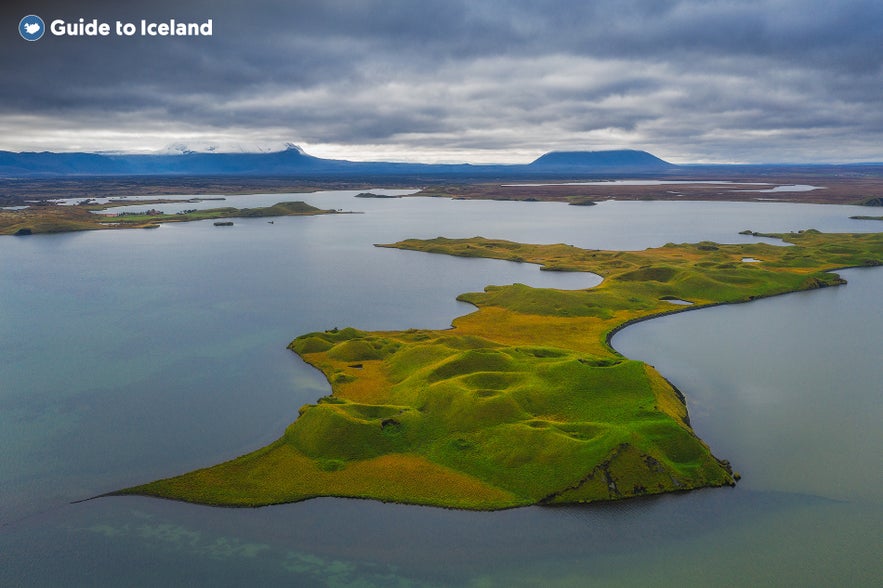 Lake Myvatn is one of the most famous attractions in North Iceland. The lake and its surrounding area are characterized by volcanic craters, lava formations, and hot springs that were all shaped by a large volcanic eruption 2,300 years ago. This unique landscape makes it one of Iceland's most distinctive and diverse natural areas, and it's a key part of the Diamond Circle route.
Lake Myvatn is one of the most famous attractions in North Iceland. The lake and its surrounding area are characterized by volcanic craters, lava formations, and hot springs that were all shaped by a large volcanic eruption 2,300 years ago. This unique landscape makes it one of Iceland's most distinctive and diverse natural areas, and it's a key part of the Diamond Circle route.
Myvatn is the fourth largest lake in Iceland, and it's special due to its rich birdlife and the numerous small pseudo craters known as Skutustadagigar that dot its surface. There are walking paths along the coastline where you can comfortably walk along the craters!
- Check out the Ultimate Guide to Lake Myvatn
You can see the region's volcanic past in its many attractions. Close to Myvatn is the Hverfell crater, which makes for a stunning hike. You can also visit the Krafla volcano, known for its striking caldera, along with the Viti crater, a geothermal lake formed in the aftermath of an eruption.
The Namafjall area, also known as Hverir, is another geothermal wonder near Myvatn and the Viti crater. It is characterized by boiling mud pots, steaming fumaroles, and a distinct sulphuric smell, offering a stark contrast to the lush greenery around the lake.
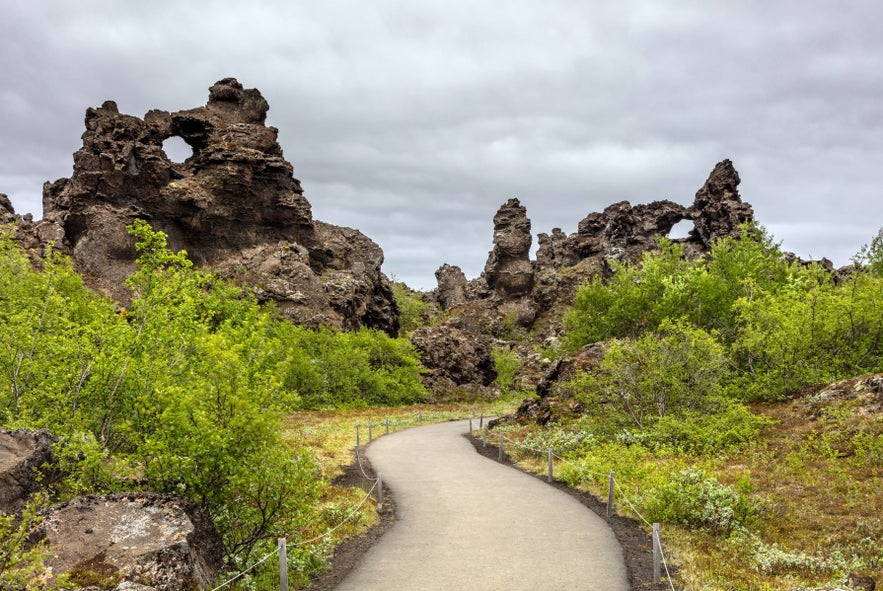 On the edge of lake Myvatn, you'll find Dimmuborgir, a vast area of unusually shaped lava fields and rock formations. These dramatic structures, formed from a volcanic eruption over 2,000 years ago, create an almost otherworldly landscape, and there are plenty of walking and hiking paths to choose from.
On the edge of lake Myvatn, you'll find Dimmuborgir, a vast area of unusually shaped lava fields and rock formations. These dramatic structures, formed from a volcanic eruption over 2,000 years ago, create an almost otherworldly landscape, and there are plenty of walking and hiking paths to choose from.
With so many areas to explore, it's best to spend a few days in the area. There are plenty of accommodation options in Myvatn, so you don't have to miss out on any of the beautiful surrounding nature. Alternatively, lake Myvatn is just an hour's drive from the largest town in the North, so you could also choose to base your adventure from accommodation in Akureyri.
Cultural Attractions in North Iceland
There's a plethora of interesting locations in North Iceland that will let you immerse yourself in the culture of the region. Here are some of the best places to include on your itinerary!
Myvatn Nature Baths

Photo from Serene Geothermal Bathing at the Myvatn Nature Baths
Lake Myvatn is one of the most stunning natural attractions in North Iceland, so you shouldn't miss out on quite literally bathing in the region's landscapes! The Myvatn Nature Baths are just a few minutes away from lake Myvatn and offer stunning views of the area while you unwind in vibrant blue geothermal water.
The Myvatn Nature Baths are the North's answer to the Blue Lagoon, and it's one of the more luxurious experiences to have during a trip to the region. The waters are rich in minerals, particularly sulfur, which are believed to have skin-healing benefits, making it a popular destination for those seeking natural wellness treatments. The water ranges from 97-104° Fahrenheit (36-40° Celsius), so you can be sure that the water will be comfortable!

Photo from Serene Geothermal Bathing at the Myvatn Nature Baths
Along with the baths themselves, you can enjoy the steam bath, which has a large window facing nature. You can also grab a delicious drink at the swim-up bar, either with or without alcohol.
Afterward, enjoy a treat at the Kvikan café where you can find sandwiches, smoothies, salads, and the soup of the day. There's also a selection of pastries to enjoy with a cup of tea or coffee.
Don't miss out on this relaxing stop while you're in the Myvatn area. We recommend booking your Myvatn Nature Bath visit for the evening, as it's usually open until 10 PM! In the summer, this means you can enjoy the midnight sun, and in the winter, you can enjoy the sunset and starry skies. If luck is with you, there's even a chance of spotting the northern lights from the geothermal water!
Laufas Turf House
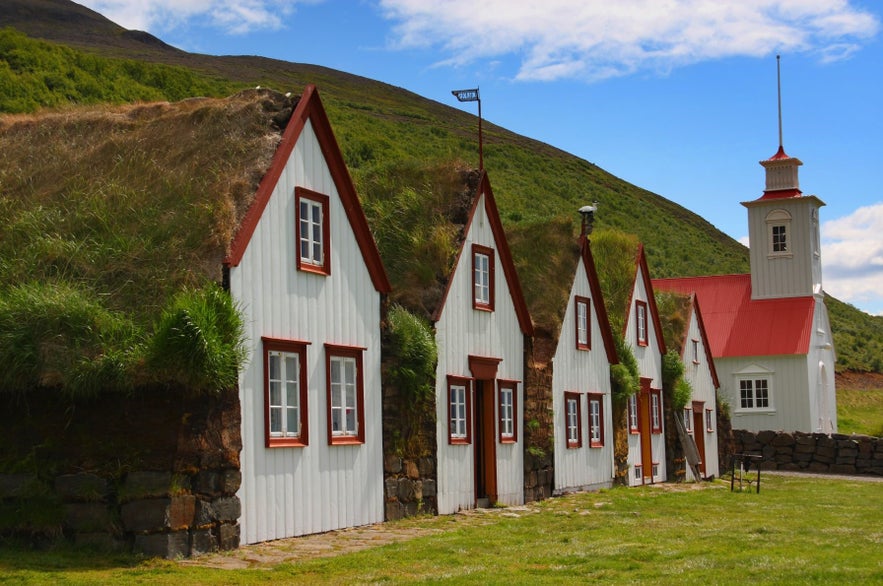
Turf homes have been around for as long as people have been constructing shelters. Many older Icelanders can recount that their grandparents were born or, in fact, grew up in turf homes as they were still common until the 1920s! However, the building style mostly disappeared in the early 20th century as wood, stone, and then concrete houses took over.
The turf houses that are still preserved today tend to be the homes of the Icelandic upper class, and the Laufas turf house is a great example. It's a 25-minute drive from Akureyri, and it has a history almost as old as that of the first settlers.
Laufas was mentioned in settlement records from between 874 and 930, but the houses you can visit today were built between 1853 and 1882. The houses were owned by reverend Björn Halldórsson, and there were usually between 20 and 30 people working there!
A visit to Laufas is almost equivalent to traveling back in time, as it's fully furnished as it would have looked around the turn of the 20th century. They're a very typical example of the building style of the time, though it's much larger than the average Icelander would have been used to.

Photo from Wikimedia, Creative Commons, by Åsa Berndtsson. You can see a 1890's sewing machine and a spinning wheel in the corner.
Along with the size of Laufas, the social status of the house's owners is reflected in the amount of wood paneling used inside, as it was an expensive building material in a mostly treeless land!
Next to the farm, you'll find a beautiful wooden church that was built in 1865, but like Laufas, its history is older. One of the key artifacts from the church is a pulpit, which dates from 1698!
The Laufas farm is part of the National Museum of Iceland's house collection and is run by the Museum of Akureyri. This is truly a historic gem to add to your North Iceland itinerary, so don't miss out on this peak into Iceland's past!
Bjorbodin Beer Spa

Photo from Unforgettable 1 Hour Bjorbodin Beer Spa Tour in North Iceland
For those seeking some unique pampering, you can stop by is the quirky Bjorbodin Beer Spa. The spa first opened in 2017 in the town of Arskogssandur, about a 10-minute drive from Dalvik. Askogssandur was already known for its Kaldi brewery, so the owners felt a beer spa was the next logical step.
For beer lovers, a visit to Bjorbodin is a must! You'll be able to bathe in warm, young beer and live yeast. To top it off, each beer bath is accompanied by a draft beer tap next to it, so you can serve yourself a cold one while you relax!

Photo from Unforgettable 1-Hour Bjorbodin Beer Spa Tour in North Iceland
You can also check out the outdoor hot tubs! They're filled with regular Icelandic water, but they offer an amazing view of the surrounding mountains, the ocean, and Hrisey island.
It'll come as no surprise that there's a bar at the spa, but you can also grab a meal at the on-site restaurant. To make your visit even more convenient, the Kaldi Brewery also runs the Kaldi Hotel. It's just a 7-minute walk from Bjorbodin, so you don't have to worry about driving after your spa visit!
The Kaldi Hotel has an average rating of 4.8 out of 5 stars from 17 reviews, and a light breakfast is included in your stay.
Did you enjoy our list of the 11 Must-See Destinations in North Iceland? Which of these fantastic attractions have you seen on your journey around Iceland? Make sure to leave your thoughts and questions in the comment section below!
Otros artículos interesantes
Las 13 Mejores Cosas que Hacer en Akureyri (y Alrededores)
Descubre las 13 mejores cosas que hacer en Akureyri y sus alrededores. La ‘Capital del Norte’ de Islandia es la puerta de entrada a algunas de las mejores y más únicas experiencias en Islandia, como e...Leer más
Islandia en Primavera - La Guía Definitiva de Viaje
Islandia es un país de increíble belleza natural y la primavera es una de las mejores épocas para vivirla. Desde las auroras boreales hasta la migración de las aves, la primavera en Islandia es una...Leer más
Guía Completa de la Erupción del Volcán Litli-Hrutur en 2023
Descubre todo lo que debes saber sobre la erupción del volcán Litli-Hrutur en Islandia en 2023. ¿Qué dimensiones tuvo el lugar de la erupción? ¿Cuánto duró? ¿Es seguro visitar el volcán ahora? ¿Cuál e...Leer más

Descarga la mayor plataforma de viajes a Islandia en tu móvil para gestionar tu viaje al completo desde un solo sitio
Escanea este código QR con la cámara de tu móvil y pulsa en el enlace que aparece para añadir la mayor plataforma de viajes a Islandia a tu bolsillo. Indica tu número de teléfono o dirección de correo electrónico para recibir un SMS o correo electrónico con el enlace de descarga.




















